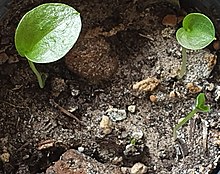| Arisarum Temporal range: 46.1 –0 Ma PreꞒ Ꞓ O S D C P T J K Pg N Middle Eocene – Recent | |
|---|---|

| |
| Arisarum vulgare | |
| Scientific classification | |
| Kingdom: | Plantae |
| Clade: | Tracheophytes |
| Clade: | Angiosperms |
| Clade: | Monocots |
| Order: | Alismatales |
| Family: | Araceae |
| Subfamily: | Aroideae |
| Tribe: | Arisareae |
| Genus: | Arisarum Mill. |
| Synonyms | |
|
Balmisa Lag. | |
Arisarum is a genus of flowering plants in the family Araceae. It is native to the Mediterranean region, east to the Caucasus and west to Macaronesia.


Taxonomy
Species
Accepted species:
| Image | Scientific name | Distribution |
|---|---|---|
 |
Arisarum simorrhinum Durieu | Portugal Spain, Balearic Islands, Algeria, Morocco |
 |
Arisarum proboscideum (L.) Savi | Spain, Italy |
 |
Arisarum vulgare O.Targ.Tozz. | Mediterranean region of northern Africa and southern Europe from Portugal and Morocco to Turkey and Israel; Caucasus; Canary Islands, Madeira, Azores |
Natural Hybrids
- Arisarum × aspergillum Dunal - Spain, Algeria, Morocco (A. simorrhinum × A. vulgare)
Phylogeny
It is closely related to the genera Ambrosina, Peltandra, and Typhonodorum. Ambrosina is the sister group to Arisarum, from which it separated about 46.1 Million years ago.
The precise relationships are displayed in the following cladogram:
| |||||||||||||||||||
Description
In A. simorrhinum, the flower stalk is shorter or equal in length to the leaf stalk, whereas in A. vulgare, the flower stalk is longer than the leaf stalk. A. vulgare also has a generally longer spadix than A. simorrhinum.
Ecology
Parasite ecology

Arisarum foliage is parasitized by the siphonous green algae Phyllosiphon arisari Kühn. It induces necrosis in leaf tissue, after invading the intracellular space. The foliage also may be affected by two species of fungi, namely Phyllosticta arisari and Melanustilospora arisari. The scale insect Icerya purchasi also feeds on Arisarum.
References
- ^ Mansion, G., Rosenbaum, G., Schoenenberger, N., Bacchetta, G., Rosselló, J. A., & Conti, E. (2008). "Phylogenetic analysis informed by geological history supports multiple, sequential invasions of the Mediterranean Basin by the angiosperm family Araceae." Systematic Biology, 57(2), 269-285.
- ^ Kew World Checklist of Selected Plant Families
- Govaerts, R. & Frodin, D.G. (2002). World Checklist and Bibliography of Araceae (and Acoraceae): 1-560. The Board of Trustees of the Royal Botanic Gardens, Kew.
- Altervista Flora Italiana, Genere: Arisarum includes European distribution maps
- "Arisarum" (PDF). Flora Iberica. Retrieved 28 November 2021.
- Aboal, M., & Werner, O. (2011). "Morphology, fine structure, life cycle and phylogenetic analysis of Phyllosiphon arisari, a siphonous parasitic green alga." European journal of phycology, 46(3), 181-192.
- W.N. Ellis. (2023). Genus Arisarum. Plant Parasites of Europe Leafminers, Galls and Fungi. Retrieved February 28, 2023, from https://bladmineerders.nl/host-plants/plantae/spermatopsida/angiosperma/monocots/alismatales/araceae/aroideae/arisarum/genus-arisarum/
External links
- [REDACTED] Media related to Arisarum at Wikimedia Commons
- [REDACTED] Data related to Arisarum at Wikispecies
This Araceae-related article is a stub. You can help Misplaced Pages by expanding it. |



